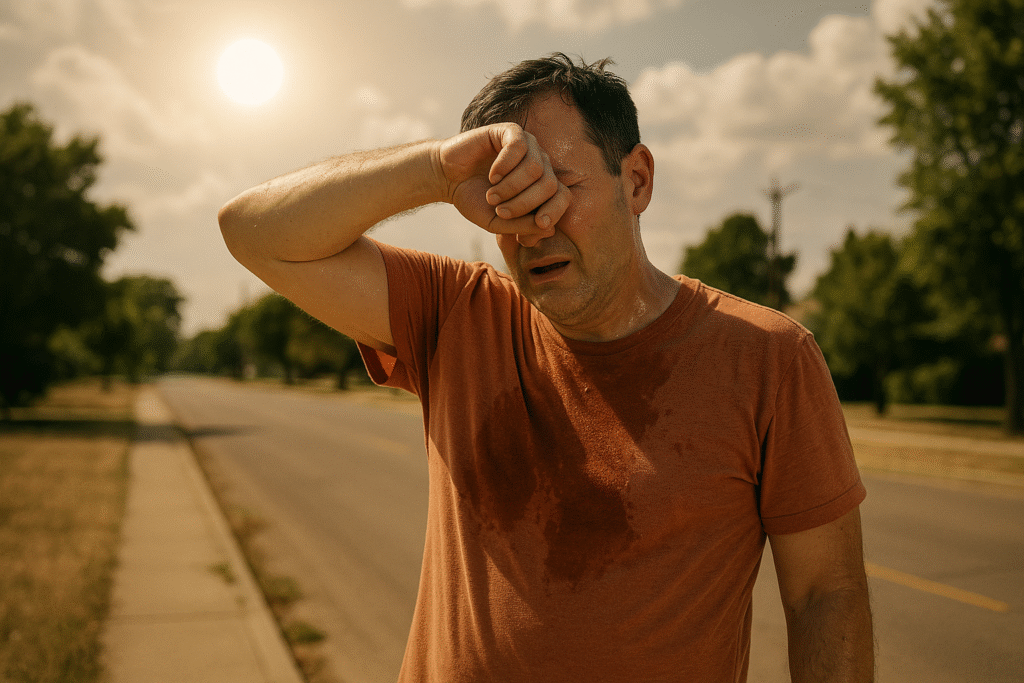
The United States is experiencing a noteworthy heatwave in summer 2025. A warm arch presently covers over 100 million individuals. Locales from the Midwest to the Southeast are confronting perilous warm record values that are rising above 110°F. This extraordinarily warm posture is a genuine open wellbeing emergency.
Everybody needs to understand how warmth influences the body. Knowing the signs of warm weariness and warm stroke might spare lives. This article looks at current heatwave conditions, distinguishes who is most at risk, provides wellbeing tips, and clarifies how communities are responding.
Unprecedented heat on America
In July and August 2025, various states recorded record-breaking temperatures. Hot record values – curb heat and humidity – from 105 ° F to 115 ° F in many areas.
New York, St. Louis, and parts of the Southeast issued extraordinary heat notices. Numerous communities experienced strong mugginess that made it about impossible to cool down at night.
Experts caution that these conditions are the modern standard. Climate alter has escalated warm arches that trap rankling discussions over districts. Considerations appear that warmth such occasions are rising more quickly than anybody anticipated.
Why Warm Is America’s Deadliest Climate Threat
Heat is presently the most deadly climate risk in the US. It causes more damage than tropical storms, surges, or tornadoes. Many heat-related deaths occur indirectly-people kick the bucket from conditions of the lungs, kidneys, or heart because hot weather increases their disease.
Heat frequently plays a covered-up part in mortality. It may not show up on passing certificates, but it contributes to basic well-being emergencies. Underreporting covers the full effect of warmth on communities.
Who Is Most Vulnerable?
Certain bunches confront distant, more prominent threats from the extraordinary heat:
- Elderly individuals, particularly those over 65
- Young children and infants
- People with inveterate sicknesses like heart or lung disease
- Pregnant women
- Outdoor laborers such as development staff or agricultural labourers
- Low-income family units frequently operate without discussing conditions.
- Individuals on drugs that disable sweating or hydration
These bunches are more likely to suffer from heat-related sickness or death, even when temperatures appear moderate.
Staying Secure: Avoiding Warm Fatigue and Warm Stroke
Heat-related sickness can develop rapidly. Information and arrangement can avoid serious outcomes.
Recognize Early Caution Signs
Heat Fatigue Symptoms:
- Heavy sweating
- Cool, pale, clammy skin
- Dizziness or fainting
- Headache or nausea
- Weak, quick pulse
- Pale, damp, or flushed skin
- If untreated, it can lead to a warm stroke.
Heat Stroke Symptoms:
- Core body temperature over 103°F
- Hot, ruddy, or dry skin (may be soggy in exertional cases)
- Confusion, tumult, or slurred speech
- Fainting or seizures
- Heat stroke is a restorative crisis. It can cause organ disappointment and passing inside hours.
Immediate Actions to Take
- Take the person to a shaded or air -conditioned place.
- Cool the body with a cold towel or ice packs on the neck, armpits, and waist.
- Offer water if the individual is completely conscious.
- Call crisis administrations immediately for cases of perplexity or fainting.
- Don’t hold up for indications to escalate.
Practical Tips to Remain Secure This Summer
Follow these steps to remain secure amid warm emergencies:
- Avoid living between 10 am and 4 pm during the hot peak.
- Stay hydrated – even if you don’t feel thirsty.
- Drink regular water and include electrolyte refreshments if necessary.
- Wear free, light clothes and a hat
- Take a cool bath or relax with a clamor towel.
- Never take children, pets, or powerless people in cars.
- Check with neighbors who may stay alone or need to be cooled.
In addition, maintaining a strategic distance from alcohol and over-the-top caffeine-they dehydrate the body and disrupt its cooling capacity.
Community and Open Wellbeing Measures
- Cities and districts are adjusting quickly. Numerous have set up cooling centres in libraries, community centres, or shelters. These give secure indoor space for those without access to conditioning.
- Local wellbeing divisions empower individuals to check the HeatRisk or warm wellbeing record for their zip codes. These instruments survey hazard by combining later climate, socioeconomics, and well-being data.
- Employers are moving to open-air work plans, implementing visit breaks, and providing water and shade for labourers. Open travel may offer free rides to cooling centers amid extraordinarily warm days.
- Grassroots volunteers also serve as first responders. They convey water, set up shade, and share anticipation data. Community mindfulness campaigns remind individuals to offer assistance to those most vulnerable.
Heat, Air Pollution, and Wellbeing: Combined Threats
Heat and air pollution frequently co-occur. Later, enquire about findings that high levels of fine particulate matter (PM2.5) make heat-related hospitalisation more likely. When the discussion is contaminated, breathing becomes harder, and the body’s warm reaction weakens.
Colder evenings and stagnant discussion traps cause brown haze and particulate buildup. These heightening stretches on lungs and hearts, particularly beneficial for more seasoned populations. Wellbeing specialists suggest observing and discussing quality in addition to warm forecasts.
Long-Term Viewpoint: Adjusting to the Modern Normal
Summer heatwaves presently come earlier and last longer. Government organisations caution of rising mortality and framework strain. State and city governments confront decreased financing for crisis response, making nearby activity vital.
Urban organisers are testing with green rooftops, intelligent building materials, and shaded walkways to decrease urban heat islands. Cooling centres and strength programmes contribute to community wellbeing equitably.
Personal readiness things. As warmth becomes an installation in open wellbeing dangers, pattern information of anticipation and reaction can ensure communities.
Final Thoughts
Summer 2025 is a clear wake-up call. Extraordinary warmth is no longer rare—it’s a developing wellbeing crisis. Heat-related sickness affects tens of millions each year. In this environment, proactive behaviours matter.
Understand the indications. Remain hydrated. Look for cooling situations. Check on those at risk. And press nearby pioneers to construct more robust flexibility. Your carefulness and activity nowadays can spare lives this summer.

